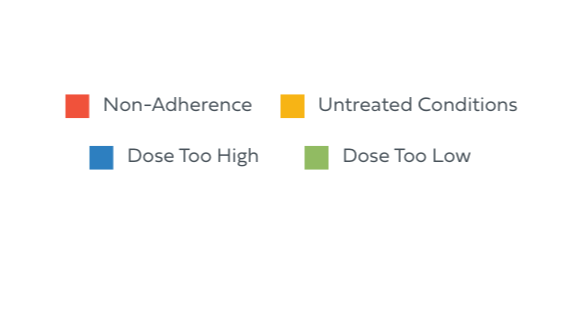
The Problem
Medication non-adherence is one of the most significant—and preventable—drivers of poor health outcomes worldwide. Even when effective treatments exist, many patients do not take their medications correctly, consistently, or at all. This gap between prescribed therapy and real-world medication use leads to worse disease control, avoidable complications, increased emergency visits, and unnecessary costs across health systems.
Non-adherence has been linked to worsening clinical outcomes, increased hospitalizations, and higher mortality across chronic conditions such as diabetes, cardiovascular disease, and hypertension [2, 9, 10, 11].
Non-optimized medication therapy—including non-adherence—is responsible for an estimated USD $528.4 billion annually in preventable healthcare costs in the United States alone [1].
Why Medication Non-Adherence Happens
Medication-taking behaviour is influenced by a mix of financial, behavioural, cognitive, and structural factors. Most patients do not intend to be non-adherent—rather, they experience obstacles that make consistent use difficult.
Cost Barriers
Many patients skip, reduce, or delay medications because they cannot afford them. Cost-related non-adherence affects millions of adults annually, especially those with lower income or insufficient insurance coverage [6, 7, 8].
Regimen Complexity
Patients managing multiple medications each day face much higher risk of unintentional non-adherence. Complex schedules, variable dosing, and multiple formulations increase the likelihood of missed or incorrect doses [4].
Behavioural & Cognitive Barriers
Memory issues, changing routines, stress, dexterity limitations, and competing priorities all make medication-taking more difficult. Managing several medications each day is demanding even for individuals who are motivated and engaged in their care [1, 4].
Low Health Literacy
Over 60% of people misunderstand their clinician’s directions immediately after their office visit.
Health literacy—the ability to understand and act on health information—is one of the strongest predictors of adherence. Patients with limited health literacy may misinterpret instructions, confuse dosing schedules, or have difficulty integrating medications into daily routines. Research shows that more than 60% of patients misunderstand their clinician’s instructions immediately after an office visit, underscoring how critical clear communication is to medication success [1].
Beliefs, Understanding & Concerns (Intentional Non-Adherence)
Some patients make a conscious decision not to take medication as prescribed—often due to fear of side effects, distrust, stigma, or uncertainty about whether the medication is necessary. These decisions are rational from the patient’s perspective and require open, empathetic discussion and collaborative care to resolve [1].
The Clinical Impact of Non-Adherence
The consequences extend well beyond missed doses. Established evidence shows:
Diabetes
Non-adherence is associated with higher HbA1c, higher blood pressure, higher LDL cholesterol, increased hospitalization, and increased mortality [2].
Cardiovascular disease
Non-adherence is linked to worse blood pressure control, more cardiac events, and accelerated disease progression [9].
General chronic disease
Non-adherent patients experience higher emergency department use, more frequent inpatient stays, and earlier disease complications [10, 11].
These effects compound over time, reducing quality of life and increasing the burden on caregivers and health systems.

The System-Level Impact
Medication non-adherence affects entire health systems—not just individuals. Research shows:
26% of hospital readmissions are medication-related, and 23.8% of these are directly due to non-adherence [3].
Non-adherent patients generate significantly higher medical costs across both inpatient and outpatient care settings [11].
Improving adherence reliably reduces hospitalizations, improves disease control, and lowers total healthcare expenditures [9, 11].
Causes of medication-related hospital readmissions
A study found 23.8% of medication-related readmissions are due to non-adherence. Other causes include untreated conditions (13.3%), dose too high (10.5%), or dose too low (10.5%).

Understanding Types of Non-Adherence
Non-adherence can take several forms:
Primary non-adherence: never filling or starting the prescription
Unintentional non-adherence: barriers such as cost, forgetfulness, low health literacy, or regimen complexity
Non-persistence: stopping medication without provider agreement
Intentional non-adherence: choosing not to take medication due to beliefs or concerns
See full definitions on the Introduction page.
Why Solving This Matters
Improving adherence represents one of the highest-value opportunities in healthcare. Even modest increases in adherence can lead to:
Better disease control
Fewer complications
Reduced hospitalizations
Lower overall system costs
This creates a strong need for practical, scalable interventions—such as pharmacist-led care, medication synchronization, and adherence packaging—to bridge the gap between prescription and real-world use.
The next pages explore evidence-based solutions, including the role of blister packaging, pharmacy support, and structured dispensing programs in improving real-world adherence.







